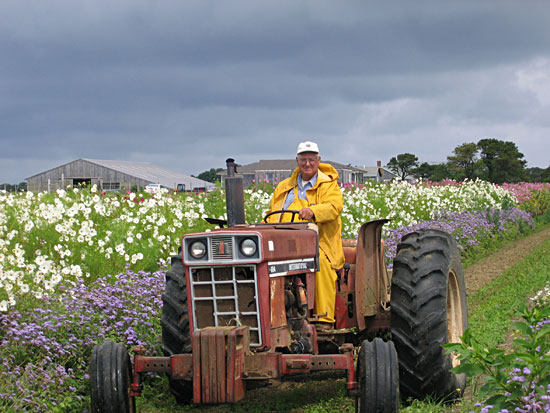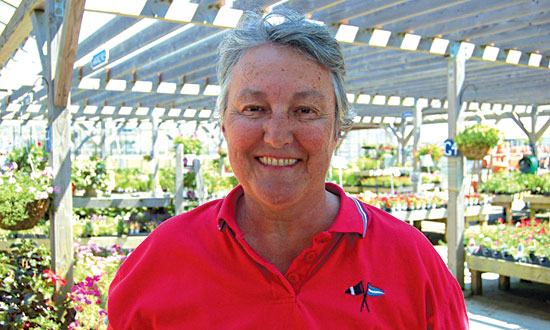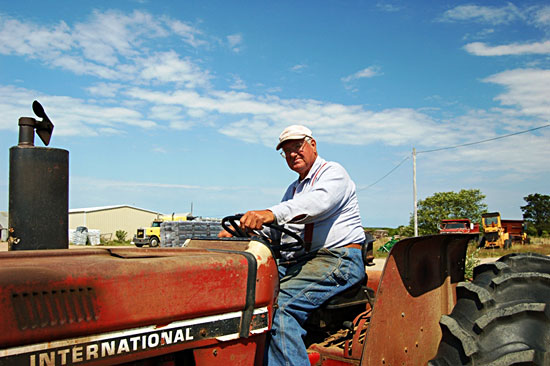Down on the Farm
by Andrew Spencer
On a rainy June morning sitting in the “Hayloft” – the multi-use event venue upstairs in the main building at Bartlett’s Farm – I can hear the unmistakable Nantucket accent wafting down the hall. “It’s wet out theyah. Wet, wet, wet.”
Phil Bartlett, the owner of the voice in question, walks in, his shoes muddy from the soil in the fields outside, soil that is as much in his blood as it is on his shoes. Phil is dressed in his standard work outfit: a Bartlett’s baseball cap faded by exposure to the sun, blue jeans, a flannel shirt and his signature red suspenders. We are joined by Phil’s wife Dorothy, one year his junior, but every bit as integral to the history of Bartlett’s Farm as Phil himself, who is still out there on his tractor and working in the fields at age 73.
Phil is the fifth generation of his family to farm the land – his great-great grandfather came from Marblehead, Massachusetts, in the 1840s and started a dairy farm out on the western end of Nantucket. Phil started working in the farming business at a relatively young age – he started, by his own recollection, when he was about ten or twelve years old. He worked for Ed Gardner, whose family farm was across what is today Hummock Pond Road from the Bartlett’s farm. “A bunch of kids always worked there,” he recalled. “We got paid over there. It was something like five cents an hour.” His work there, though, wasn’t milking cows. Rather it was growing vegetables.

Phil Bartlett - PHOTOS BY JILL SANDOLE
Phil took what he’d learned and started his own garden back at his father’s farm, raising tomatoes. At about that same time, the dairy farm was fading; the demand for milk, though high during the busy summer months, was not enough to support the farm during the winter. So the Bartletts turned to the sheep business. But Phil saw gold in those red tomatoes, and he kept growing them. By the time he was fifteen, Phil was selling tomatoes to local restaurants and Snow’s Market, which was then at the corner of Main and Federal Streets.
In his late teen years, Phil did a three-year tour in the United States Marine Corps, and then entered Cornell University, where he met his bride Dorothy. The two fell in love and were married in 1959. No stranger to the farming world herself, Dorothy grew up in her own family of farmers. Her father was a professor of agriculture and animal husbandry at Cornell, and she spent her summers as a young girl on an uncle’s poultry and dairy farm in northern Virginia.
While waiting for her husband to graduate from college – Phil was two years behind Dorothy because of his time in the military – Dorothy earned her Master’s in education from Cornell and taught, a job she would keep for five years when the two moved to Nantucket immediately following Phil’s own graduation from college.
The farm truck that so many of us have used to procure vegetables in the summer months began its daily trips to Main Street in the early 1950s. By the mid-1960’s, the Bartletts were selling vegetables and cut flowers at their farm, in addition to their efforts in town.
The farm flowers came about as a result of a request from Marine Home Center one year. Alice Erickson, who was with the retail conglomerate for many years, approached Dorothy and Phil with a request. Marine sold cut flowers at the time, and during the planting season in question, Alice had procured more bulbs than she had room to plant. She asked if the Bartletts would be willing to grow the bulbs if Alice and her crew agreed to come cut them when they were fully grown and pay for them. The Bartletts agreed, but soon realized that they could sell the flowers themselves to their own customers. From there, they began to put up greenhouses to handle the new crops.

Dorothy Bartlett in the Greenhouse area
Another customer was spotted in the greenhouse early in March. It seemed that she was taking potted petunias that were in their infancy. When Dorothy asked what she was doing, the woman replied that she’d like to buy them. Dorothy explained quite nicely that they weren’t ready yet, to which the customer explained that she wanted to plant them in her own garden now, so that when summer came, they’d be in full bloom. And thus was born the potted plant business.
And that’s how the Bartletts have expanded their business over the years – by listening to their customers. “When we learned that people would come all the way out here – you know, for a Nantucketer, this is a long trip from town,” Dorothy explained with a laugh, “we thought, ‘Well, we’ve got lettuce in the spring, so why don’t we sell that?’ And oftentimes we’d just have a cigar box that people put their money in to buy vegetables.”
Today, Bartlett’s Farm has approximately one hundred acres of cultivated fields, which are just about evenly split between flowers and vegetables, and about three acres of greenhouse space. But the husband-and-wife duo say they never anticipated the farm morphing into the business it is today.
How did a mid-nineteenth-century dairy farm become the farm of today? Phil answered that question pretty easily. “Demand,” he said. “It grew from people saying to us, ‘Well, if you had this, I wouldn’t have to go town,’” Phil explained. “Starting in nineteen-eight-six, our selling area was in the greenhouse, but that wasn’t very conducive to selling produce. And back then, we only sold what we grew.”
As the requests for additional things grew from the exotic – some patrons wanted lemons, for example, which don’t grow on Nantucket – to the more pedestrian – many people wanted paper towels and the newspaper – the Farm evolved along with the requests. And the logistics of running a business of that sort out of a greenhouse – complete with birds flying in and out at will – just “wasn’t conducive to business, even though it was quaint,” said Phil. So the family embarked on a major construction project to build the current building that houses the market, the kitchen and delicatessen and the Hayloft, in addition to offices and storage space.
The varied nature of the business means that the Bartletts employ a lot of people. The Farm was one of the first businesses on-island to offer housing for its staff, and they continue that tradition today, as the Bartletts have put eleven separate houses on Farm property, all of them to house their staff. And while the year-round crew numbers about twenty-five, come summer, they’re employing over a hundred people, with staff coming from several different countries around the world, with many coming back year after year.

Phil Bartlett
And what do the Bartletts see for the future of their beloved farm? After all, they’ve sewn the seeds – no pun intended – for the future, with four children of their own and a bevy of grandchildren running around, too. “Who can tell?” asked Dorothy. “When we started this, who would have known that today we’d be selling pre-washed lettuce in plastic bags? There’s no telling what our grandkids will be selling.” But the Bartlett family is looking to the future, as evidenced by the windmill that generates a portion of the Farm’s electrical needs.
No matter how much things change, however, there are always two things that we can count on in the summer, namely Bartlett’s tomatoes and corn. I asked Phil and Dorothy which they thought was the more popular summer fare. “I like the corn better,” Phil admitted, perhaps betraying his own youthful endeavors at growing tomatoes. “I can eat a half-dozen ears of corn, but I can’t eat a half-dozen tomatoes.”
“But we probably sell more lettuce than either corn or tomatoes day after day,” Dorothy added.
So I guess that question will have to be left up to everyone to answer for themselves.